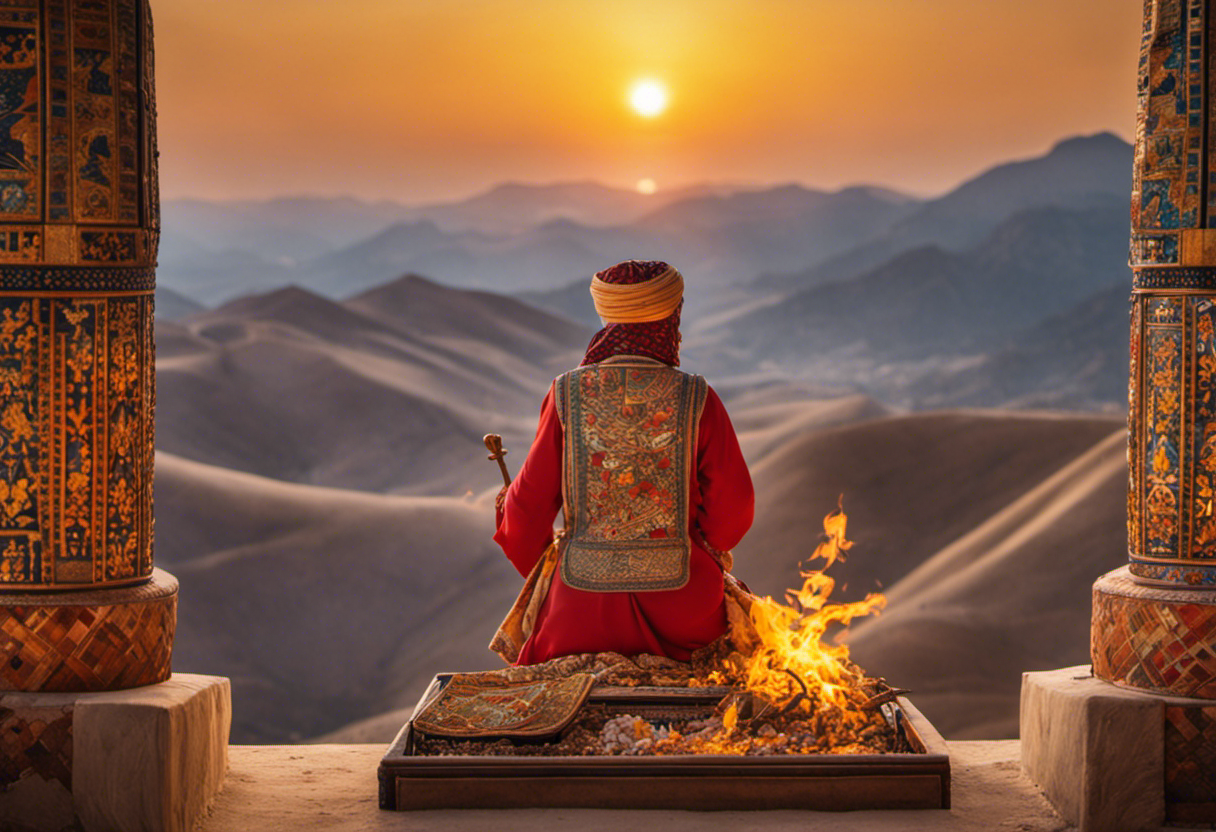In the annals of history, the migration of Zoroastrians stands as a testament to the resilience and adaptability of this ancient community.
Through their movement from Persia to India, Zoroastrians encountered new cultures and engaged in a profound exchange of ideas.
One facet of this exchange was the evolution of their calendar, which underwent significant changes to align with their new surroundings.
This article explores the historical context, cultural impact, and future challenges surrounding the migration of Zoroastrians and the evolution of their calendar.
Key Takeaways
- Zoroastrian migration occurred during the 10th century due to religious persecution and political turmoil.
- Zoroastrians migrated primarily to the Indian subcontinent, specifically Gujarat and Mumbai.
- The migration of Zoroastrians has led to the establishment of vibrant communities in India, Iran, and Pakistan.
- Zoroastrians have assimilated elements of Indian culture and adopted the Shahenshahi calendar, influencing the local calendar system.
Historical Background of Zoroastrian Migration


During the 10th century, the historical background of Zoroastrian migration was characterized by a significant influx of followers into the Indian subcontinent, where they established thriving communities amidst a backdrop of political turmoil and religious persecution. This migration led to a process of cultural assimilation, as the Zoroastrians integrated into the Indian society while also maintaining their distinct religious practices.
The Zoroastrians, fleeing from the Arab conquest of Persia, faced religious persecution and were forced to seek refuge in various regions. The Indian subcontinent provided a safe haven for these migrants, as the region was known for its tolerance towards diverse religious communities. The Zoroastrians settled primarily in Gujarat and Mumbai, where they established prosperous communities and engaged in trade and commerce.
Cultural assimilation occurred as the Zoroastrians interacted with the local population and adopted certain aspects of Indian culture. However, they also retained their unique religious practices, such as the worship of fire and the veneration of their prophet, Zoroaster. The Zoroastrian temples, known as fire temples, became centers of religious activity, where rituals and ceremonies were performed in accordance with their ancient traditions.
The migration of Zoroastrians to the Indian subcontinent not only allowed them to escape religious persecution but also enabled them to preserve their religious heritage while adapting to their new surroundings. This historical background sets the stage for the subsequent evolution of the Zoroastrian calendar, which will be discussed in further topics.
Zoroastrians: From Persia to India


The migration of Zoroastrians from Persia to India marked a significant chapter in their history, as they sought refuge and established thriving communities amidst political turmoil and religious persecution. These diaspora communities played a crucial role in preserving and evolving Zoroastrian religious practices.
Upon their arrival in India in the 8th century CE, Zoroastrians, known as Parsis, faced the challenge of adapting to a new land while maintaining their religious identity. Despite the hardships, the Parsis managed to establish successful businesses and contribute to the economic development of their adopted country.
Religious practices played a central role in the lives of the Parsis, and they made efforts to preserve their traditions while incorporating elements of Indian culture. One notable aspect of their religious practice is the Zoroastrian calendar. The Parsis adopted the Shahenshahi calendar, which originated in Persia but was modified to align with the Indian solar year. This calendar is still used by the Parsis today and serves as a testament to their ability to adapt and evolve in their new homeland.
Overall, the migration of Zoroastrians to India not only allowed them to escape persecution but also led to the establishment of vibrant diaspora communities that played a vital role in the preservation and development of Zoroastrian religious practices. The Parsis’ ability to adapt their traditions while maintaining their identity is a testament to their resilience and commitment to their faith.
Cultural Exchange and Calendar Adaptation


Frequently, cultural exchange between different societies has led to the adaptation and modification of calendars, as seen in the case of the Zoroastrians who incorporated elements of Indian culture into their religious practices and adopted the Shahenshahi calendar to align with the Indian solar year. This cultural assimilation and religious syncretism took place when a significant number of Zoroastrians migrated from Persia to India in the 10th century CE, seeking refuge from persecution. The Zoroastrians, also known as Parsis, settled in Gujarat and gradually integrated with the local Indian population.
The adoption of the Shahenshahi calendar by the Zoroastrians demonstrates their willingness to embrace aspects of Indian culture while preserving their religious identity. The Shahenshahi calendar is a solar calendar that was already in use in India, and its adoption allowed the Zoroastrians to synchronize their religious festivals and rituals with the Indian solar year. This exchange influenced not only the Zoroastrian community but also had a broader impact on the Indian calendar system.
This example highlights how cultural exchange can lead to the assimilation and modification of traditions and practices, contributing to the evolution of calendars. It showcases the dynamic nature of societies and their ability to adapt and integrate elements from different cultures, resulting in the creation of new cultural and religious syncretism.
The Impact of Zoroastrianism in New Lands


While Zoroastrianism has had a significant impact on new lands, its influence can be seen in various aspects of culture, including religious practices, social structures, and even political systems.
Zoroastrians have historically migrated to different regions, bringing with them their unique beliefs and customs. As they settled in these new lands, they interacted with local communities and influenced their customs and practices.
One of the most prominent ways in which Zoroastrianism has influenced local customs is through its emphasis on religious tolerance. Zoroastrians have a long history of coexisting with other religious communities, and this has had a lasting impact on the communities they have settled in. The principles of religious tolerance and respect for other faiths have often been adopted by the local populations, leading to a more inclusive and diverse religious landscape.
Furthermore, Zoroastrianism has also influenced social structures in new lands. The emphasis on purity, honesty, and ethical conduct in Zoroastrianism has had a profound impact on the social norms and values of the communities they have integrated into. These principles have helped shape the moral fabric of these societies, promoting fairness, justice, and compassion.
Lastly, the political systems of the regions where Zoroastrians have settled have also been influenced by their presence. Zoroastrianism’s emphasis on individual responsibility, good governance, and the pursuit of truth has often influenced the political ideologies and systems of these regions. The principles of justice, equality, and truth-seeking have been incorporated into the political structures, leading to more accountable and transparent governance.
Modern Challenges and the Future of the Zoroastrian Calendar


One major challenge facing the Zoroastrian community today is the need to adapt the traditional calendar to the demands of modern society, as it requires both preserving cultural heritage and accommodating practical considerations.
The Zoroastrian calendar, known as the Shahenshahi calendar, has been in use for centuries and is closely tied to religious and cultural practices. However, with the increasing globalization and integration of the Zoroastrian community into diverse societies, there is a growing need to address the modern challenges posed by the traditional calendar.
The evolution of the Zoroastrian calendar is a complex issue that requires careful consideration. On one hand, preserving the calendar’s historical and cultural significance is vital to maintaining the identity of the community. On the other hand, there is a need to accommodate practical considerations such as aligning with the Gregorian calendar for administrative purposes and facilitating the organization of events and festivals.
Various proposals have been put forward to address these challenges. Some suggest modifying the Shahenshahi calendar to incorporate elements of the Gregorian calendar, while others propose creating a new hybrid calendar that combines elements of both. These proposals aim to strike a balance between preserving cultural heritage and meeting the practical needs of the Zoroastrian community in the modern world.
Conclusion
In conclusion, the migration of Zoroastrians and the subsequent evolution of their calendar highlight the rich cultural exchange that took place between Persia and India. The adaptation of the calendar in new lands demonstrates the impact of Zoroastrianism on different cultures and societies.
However, despite the challenges faced by the Zoroastrian community in modern times, the future of their calendar remains uncertain. Irony lies in the fact that while the calendar has endured for centuries, its future now hangs in the balance.



